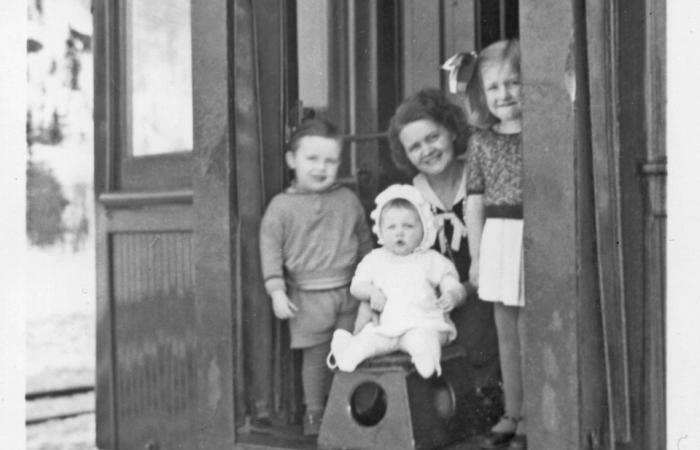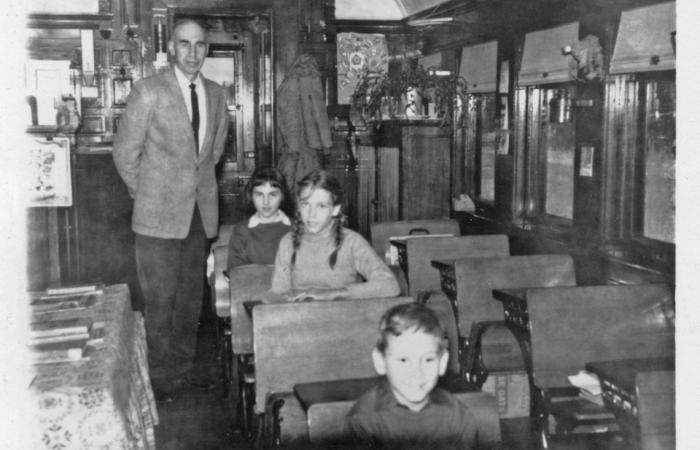These last two years have been difficult ones for school children because of the pandemic. Transitioning from classroom to computer has taken its toll, and while most kids (and parents) have handled it admirably, it’s not a choice many would willingly make. Imagine then, if your classroom was a train car, your teachers its crew, and you had to cram a month’s worth of learning into a one-week educational block? That’s exactly what happened in Northern Ontario in 1928 -1967, with the arrival of the Train School Car program, and teachers William and Helen Wright!
“Talk about ‘online’ or ‘remote’ learning,” says author/historian Bonnie Sitter. “The C.P.R. School Car #2 was a converted rail passenger coach car built in 1898 that moved along the rails from one mile post to the next during the regular school year. The formula of teaching at each stop for a week and leaving each student with four weeks of homework was not easy, but there was little road access to northern communities back then. William Wright began teaching in 1928 and School Car #2 was his classroom. It traveled from Chapleau
to White River and back again. At one time there were seven School Cars in northern Ontario!”
The cars were conceived in the mid 1920s by J. B. MacDougall of the Ontario Ministry of Education. Their purpose was to deliver education to the children of railway workers who lived and worked at isolated locations along the railways of Northern Ontario. In fact, all children were welcome, and not all of them spoke English.
While the first School Car route for Wright was Fort William to Kenora (1928 to 1937), he spent the next 40 years on the Chapleau – White River route. It served the remote stops of Esher, Nicholson, Bolkow, Carry, Grassett and Amyot. The car would be pulled by a freight train from one stop to the next where it would be shunted off the main line for a week during which time, local children would be given a week of intensive teaching. They would then be given homework assignments to be completed before the train returned. One cycle from Chapleau to White River would last about a month.
“Interestingly, the Train School Car was not only a travelling school, but it was the Wright’s home,” says Sitter. “William was the teacher, and he traveled with his wife Helen and their four children, Shirley, Harvey, Nancy and Chris. Helen was also a qualified teacher, and she served to support her husband, keep their home running smoothly, and give the extra help to the students when needed.”
The classroom was 22 feet long and 9 feet wide, with a living room of 9’x12’ and a kitchen of 9’x9’.
“Tiny homes are all the rage now,” says Sitter with a grin.
Sitter lives in Exeter and has written several books on rural Ontario. She was researching the story of Fred Sloman who taught in C.N.R. School Car # 1 in 1926 on the Chapleau to Foleyet route. Through a series of coincidental contacts, she happened across Harvey Wright, one of William and Helen’s children. Harvey mentioned that his sister Nancy had written her childhood memories and he put her in touch with Sitter, who suggested they publish them. Not only did Nancy agree, but all four (now senior) children wrote their memories, complete with several fascinating photos of this remarkable time.
“It was a very remote existence,” says author/historian William McLeod. “Those kids would have to be raised without the benefit of much interaction with peers their own age. They made their own fun doing puzzles, playing board games, snaring rabbits, fishing and scavenging pop bottles that had been thrown from passing trains. In season, they picked blueberries which they sold in Campbellford. They did very well on the Grade Eight high school entrance exams that were required in those days, and most went on to post-secondary education. They had nothing but good things to say about their early lives on the Train School Car.”
In 1946, the Wrights built a cottage on Wangoon Lake, but when William and Helen retired in 1967, they moved south to Bobcaygeon, Ontario. Before leaving Chapleau, however, they were honoured at a reception arranged by the teachers of Chapleau High School, and by the Reeve and Councillors of the town.
“This project was not on my horizon, but I’m so glad it happened,” says Sitter. “I love Ontario history and knew that this important part of Ontario education and life in the north would be lost if I didn't make the effort.”
Considering how little is known about our own Northern Ontario School Cars, I’m glad she made the effort too! To find out more about Bonnie Sitter and her rural Ontario books, check out her website at https://bonniesitterphotography.wordpress.com. Work by Bill McLeod can be found at www.billmcleodbooks.com.





